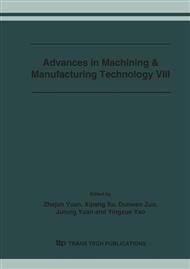p.838
p.843
p.847
p.852
p.856
p.860
p.864
p.868
p.872
A Model for Milling Force Prediction in High-Speed End Milling of P20 Mold Steel
Abstract:
This paper focuses on developing an empirical model for the prediction of milling forces in high-speed end milling of P20 die-mold steel. The spindle speed, feed rate, axial and radial depth of cut are considered as the affecting factors. The data for establishing the model are derived from high-speed end milling experiments conducted on a 5 axis machining center according to the principles of DOE (design of experiments) method. The influences of milling parameters on milling forces are investigated by analyzing the experimental curves. Consequently, multiple-regression analysis is applied in developing the empirical model. Furthermore, the significances of the regression equation and regression coefficients are statistically tested in this paper to validate the model.
Info:
Periodical:
Pages:
856-859
Citation:
Online since:
July 2006
Authors:
Price:
Сopyright:
© 2006 Trans Tech Publications Ltd. All Rights Reserved
Share:
Citation:


